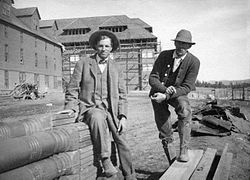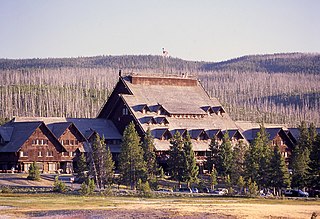
The Old Faithful Inn is a hotel in the western United States with a view of the Old Faithful Geyser, located in Yellowstone National Park, Wyoming. The Inn has a multi-story log lobby, flanked by long frame wings containing guest rooms. In the western portion of the park, it sits at an approximate elevation of 7,350 feet (2,240 m) above sea level.

Fort Yellowstone was a U.S. Army fort, established in 1891 at Mammoth Hot Springs in Yellowstone National Park. Yellowstone was designated in 1872 but the Interior Department was unable to effectively manage the park. Administration was transferred to the War Department in August 1886 and General Philip Sheridan sent a company of cavalry to Mammoth Hot Springs to build a cavalry post. The army originally called the post Camp Sheridan in honor of General Sheridan but the name was changed to Fort Yellowstone in 1891 when construction of the permanent fort commenced. The army administered the park until 1918 when it was transferred to the newly created National Park Service. The facilities of Fort Yellowstone now comprise the Yellowstone National Park headquarters, the Horace Albright Visitor Center and staff accommodations.
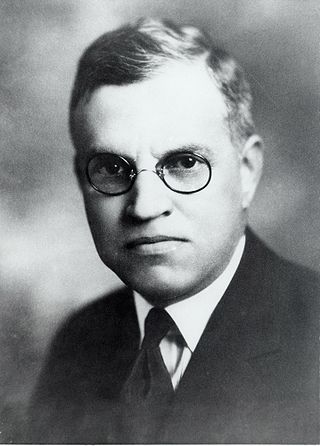
Robert Chambers Reamer (1873–1938) was an American architect, most noted for the Old Faithful Inn in Yellowstone National Park. A number of his works are listed on the National Register of Historic Places for their architecture.

National Park Service rustic – sometimes colloquially called Parkitecture – is a style of architecture that developed in the early and middle 20th century in the United States National Park Service (NPS) through its efforts to create buildings that harmonized with the natural environment. Since its founding in 1916, the NPS sought to design and build visitor facilities without visually interrupting the natural or historic surroundings. The early results were characterized by intensive use of hand labor and a rejection of the regularity and symmetry of the industrial world, reflecting connections with the Arts and Crafts movement and American Picturesque architecture.

The Norris Geyser Basin Museum, also known as Norris Museum, is one of a series of "trailside museums" in Yellowstone National Park designed by architect Herbert Maier in a style that has become known as National Park Service Rustic. It is listed on the National Register of Historic Places, and is one of three parts of a National Historic Landmark, the Norris, Madison, and Fishing Bridge Museums, which were funded by Laura Spelman Rockefeller's grant of $118,000. Built 1929 - 1930, the Norris Museum is sited on a hill between the Porcelain Basin and the Back Basin of Norris Geyser Basin. Its central breezeway frames a view of the Porcelain Basin for arriving visitors.

The Madison Museum is one of a series of "trailside museums" in Yellowstone National Park designed by architect Herbert Maier in a style that has become known as National Park Service Rustic. It was listed on the National Register of Historic Places in 1982, and is one of three parts of a 1987-declared National Historic Landmark, the Norris, Madison, and Fishing Bridge Museums. Built in 1929, the Madison Museum is the smallest of the three. It is sited on a small rise that overlooks the meadows and canyon of the Madison River, and still fulfills its function as an informal interpretive center.

Mission 66 was a United States National Park Service ten-year program that was intended to dramatically expand Park Service visitor services by 1966, in time for the 50th anniversary of the establishment of the Park Service.

The Lake Hotel, also known as Lake Yellowstone Hotel is one of a series of hotels built to accommodate visitors to Yellowstone National Park in the late 19th and early 20th century. Built in 1891, it is the oldest operating hotel in the park. It was re-designed and substantially expanded by Robert Reamer, architect of the Old Faithful Inn in 1903. In contrast to the Old Faithful Inn and many other western park facilities, the Lake Hotel is a relatively plain clapboarded Colonial Revival structure with three large Ionic porticoes facing Yellowstone Lake. It was designated a National Historic Landmark in 2015.

The Old Faithful Historic District in Yellowstone National Park comprises the built-up portion of the Upper Geyser Basin surrounding the Old Faithful Inn and Old Faithful Geyser. It includes the Old Faithful Inn, designed by Robert Reamer and is itself a National Historic Landmark, the upper and lower Hamilton's Stores, the Old Faithful Lodge, designed by Gilbert Stanley Underwood, the Old Faithful Snow Lodge, and a variety of supporting buildings. The Old Faithful Historic District itself lies on the 140-mile Grand Loop Road Historic District.
Hamilton's Stores were concessioners in Yellowstone National Park from 1915 to 2002. The stores were founded by Winnipeg native Charles Hamilton, who arrived in Yellowstone in 1905, aged 21, to work for the Yellowstone Park Association. The stores provided tourists with food, souvenirs, and sundries at the major attractions along Yellowstone's Grand Loop Road. Several buildings constructed for Hamilton are significant examples of the National Park Service Rustic style of architecture and have assumed prominence as attractions in their own right. Most are included as contributing structures in National Register of Historic Places historic districts.

Old Faithful Lodge in Yellowstone National Park is located opposite the more famous Old Faithful Inn, facing Old Faithful geyser. The Lodge was built as a series of detached buildings through 1923 and was consolidated into one complex by architect Gilbert Stanley Underwood in 1926-27. The Lodge is included in the Old Faithful Historic District.

The Mammoth Hot Springs Historic District is a 158-acre (64 ha) historic district in Yellowstone National Park comprising the administrative center for the park. It is composed of two major parts: Fort Yellowstone, the military administrative center between 1886 and 1918, and now a National Historic Landmark, and a concessions district which provides food, shopping, services, and lodging for park visitors and employees. It was added to the National Register of Historic Places on March 20, 2002, for its significance in architecture, conservation, entertainment/recreation, and military. The district includes 189 contributing buildings.
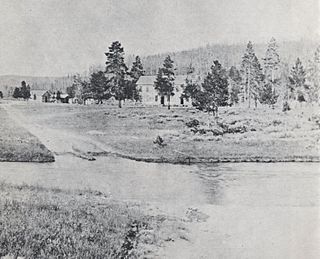
Marshall's Hotel, subsequently known as the Firehole Hotel was the first public accommodations built in the Firehole River geyser basins of Yellowstone National Park and among the earliest tourist hotels in Yellowstone. The first hotel was built in 1880 by George W. Marshall (1838-1917) and his partner John B. Goff and was located just west of confluence of the Firehole River and Nez Perce Creek. A second hotel, the Firehole Hotel, was built in 1884 in partnership with George Graham Henderson very near the present day Nez Perce Picnic area. The hotels operated for eleven years under various ownership ceasing operation in 1891. By 1895, all the structures except a few cabins associated with the two hotels had been razed.
The Old Faithful Museum of Thermal Activity was one of a series of four "trailside" museums built in Yellowstone National Park in 1929. Funded by a grant of $118,000 from Laura Spelman Rockefeller, the museums interpreted park features for visitors, and represented an early version of the visitor information center concept that became widespread throughout the National Park Service. The four museums were notable examples of the National Park Service Rustic style, and all were designed by Park Service architect Herbert Maier. The surviving Norris Museum, Fishing Bridge Museum and the Madison Museum are collectively listed as National Historic Landmarks.
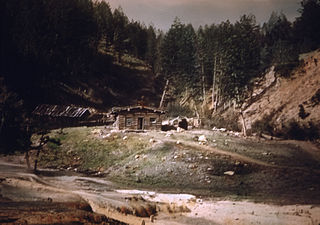
Since before the creation of Yellowstone National Park in 1872, entrepreneurs have established hotels and permanent tourist camps to accommodate visitors to the park. Today, Xanterra Parks and Resorts operates hotel and camping concessions in the park on behalf of the National Park Service. This is a list of hotels and permanent tourist camps that have operated or continue to operate in the park.

Harry W. Child (1857–1931) was an entrepreneur who managed development and ranching companies in southern Montana. He was most notable as a founder and longtime president of the Yellowstone Park Company, which provided accommodation and transportation to visitors to Yellowstone National Park from 1892 to 1980. Child was, with park superintendent and National Park Service administrator Horace Albright, singularly responsible for the development of the park as a tourist destination and for the construction of much of the park's visitor infrastructure.

The Lake Quinault Lodge is a historic hotel on the southeast shore of Lake Quinault in the Olympic National Forest in Washington, US. The hotel was built in 1926 and designed by Robert Reamer, a Seattle architect, in a rustic style reminiscent of Reamer's work at the Old Faithful Inn in Yellowstone National Park. It is a notable example of a rustic wilderness lodging, suited to its woodland environment on the southern side of the Olympic Mountains.

Grant Village is a developed area of Yellowstone National Park, offering lodging, camping and other visitor services. It is located on the southwest side of Yellowstone Lake, about 2 miles (3.2 km) south of West Thumb Geyser Basin. Grant Village was developed by the National Park Service and concessioners under the Mission 66 program, in an effort to relocate land-consuming visitor services and accommodations away from the park's major attractions and sensitive features. Grant Village was planned to allow the removal of development encroaching on the thermal basin at West Thumb. Originally named "Thumb Bay," the development was first proposed in 1955 by Park Service director Conrad L. Wirth to accommodate 2500 visitors with restaurants, gas stations, concessions and a marina.
Firehole Village was a proposed visitor services development in Yellowstone National Park, planned to divert development away from the sensitive area around Old Faithful. The project was proposed under the Mission 66 program, which sought to improve visitor services and park infrastructure throughout the National Park Service system. Although Firehole Village was never built, it was complemented by projects at Grant Village and Canyon Village, both of which were partially executed. The Firehole Village project, initially named "Wonderland," envisioned the demolition of the Old Faithful Inn, Old Faithful Lodge and other development in the Old Faithful area, restoring the area to a more natural appearance. The new development was planned for the area of the Lower Geyser Basin. First proposed in 1955, the Firehole Village plan was finally abandoned in 1964.

Gardiner station was a railway station in Gardiner, Montana, serving the Northern Pacific Railway. Gardiner was on the southern terminus of a branch line from Livingston and is at the northern border of Yellowstone National Park. Passengers would be shuttled to/from the park via stagecoach. The station was designed by Robert Reamer in the rustic style. Passenger service eventually diminished from Gardiner, and the station was torn down in 1954.


